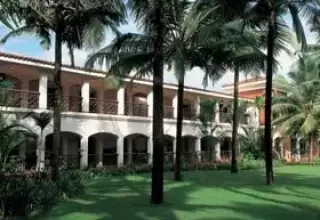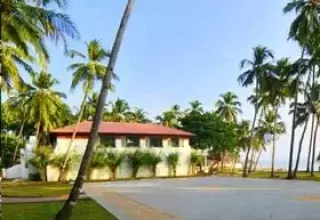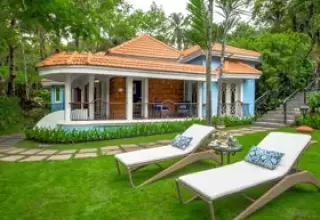
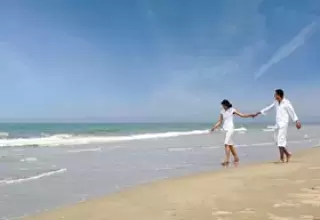
Vivanta by Taj Holiday Village Goa
Address: Sujan Singh Park, Subramaniam Bharti Marg, New Delhi, Delhi 110003
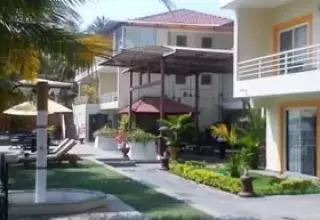
Deltin Palms Goa
Address: House 542/1, Village Penha-De-Franca, Next to Britona Church, Britona, Goa 403101 India.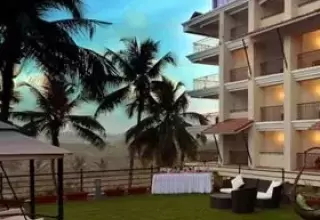
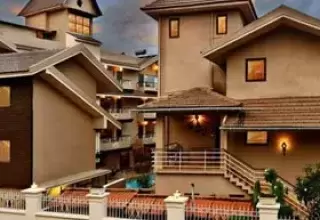
La Sunila Clarks Inn Suites, Goa
Address: Dr Constancio Maschrans, River View, Arpora - Baga Road, Bardez, Arpora, Goa 403518 India.Luxury Hotels and Resorts in Goa
Goa Today: India's Small, Young and Exotic State
Vote only for intellectual gains. Fabulous wealth can bring no status. Books: Your only choice for Calibre & grandeur. Biggest choice for every taste. Golden Heart Emporium, Margao.
Advertisement in the Navhind Times, November 16, 1994
Picture yourself in a friendly beach cafe sitting over a glass of feni and a plate of grilled tiger prawns, gazing at the seemingly endless, sparsely populated beach fringed by swaying palms on one side and the lapping waves of the Arabian Sea on the other. An hour or so passes. The sun lowers, softens and transforms from hot white to a mellow orange before dropping behind the horizon. The sky ripens into an unforgettable blood-red sunset.
This is just one image of Goa. Behind it, India's second newest state is pumping into life. On 30 May 1987, Goa was upgraded to become the 25th state of the Indian Union; until then, it had been a Union Territory since it won independence from Portuguese colonial rule on 19 December 1961.
Goa -The Perfect Location
Goa covers just 3,702 square kilometres (1,446 square miles), roughly the same as the counties of West and East Sussex in England, a tiny drop in India's total 3,166,414 square kilometres (1,23,6881 square miles). To compare further, it is roughly the same size as Luxembourg and Mauritius, and six times as big as Singapore. Lying in the Tropic of Cancer between 14 and 15 degrees latitude and 73 and 74 degrees longitude, Goa is in line with other exotic destinations such as Hawaii and the Caribbean. Its land borders are the huge states of Maharashtra to the north, with Bombay (now called Mumbai) as its capital, and Karnataka to the east and south where Bangalore is the capital. On the west, its 106 kilometres (66 miles) of coastline meet the Arabian Sea. Although small, Goa's geography is varied. The land rises from sea level eastwards a bare 60 kilometres (37 miles) before reaching the richly forested hills of the Sahyadri mountain range, part of the Western Ghats, which run from Mumbai down to Mangalore; their highest Goa peak is Sonsagar. These have helped cut Goa off from the flat, high Deccan Plateau to the east, and thus from the rest of India. They also encourage Goa's distinct culture and lush setting , for from those hills flow Goa's rivers, its lifeblood. They nourish the paddy (rice) fields, provide transport networks and flow down to perfect sites for thriving port-cities. The two principal rivers are the Mandovi which flows roughly westwards down past Panaji, and the Zuari which flows northwards into Mormugao Bay; both carry goods down to the busy, international harbour of Mormugao. Together with the Tiracol River along the northern border and the Chapora, Betul, Sal, Talpona and Galgibaga rivers, Goa has 253 kilometres (158 miles) of navigable highway throughout the year.
The estuaries, creeks and bays of Goa's rivers break the almost continuously sandy, palm-fringed coastline behind which live the coastal people among their coconut groves and fishing villages. These estuaries are home to a wide range of waterfowl, and their mixture of salt and fresh water is ideal for a wide variety of mangrove trees (some unique to Goa) whose roots hold the banks in place The surrounding rocky headlands overlooking the estuaries are topped by ancient forts which testify to Goa's strategic position on the Arabian Sea trading routes.
Goa's local stone is the blood-red, pit-holed, volcanic laterite. Its advantage is its softness, making it easy to quarry and carve, its disadvantage is that it then hardens only slightly. If left unplastered and open to the monsoon, it quickly weathers and grows moss. On cliffs, on beach coves or revealed beneath the white plaster of Old Goa's churches, it glows wonderfully in the late afternoon sun.
Goa's climate is almost ideal. From late September until the end of March, days are warm and sunny with maximum daytime temperatures of 30-33°C, cooled by fresher breezes at night and little or no rain. In summer, the humidity rises and during the southwest monsoon Goa receives more than 2 000 millimetres (80 inches) of its total annual rainfall of 2,300-4,800 millimetres (90-190 inches).
Towns, People and Literacy: Goa is Different
Panaji is Goa's capital city, still affectionately known by its pre-liberation name of Panjim. With not a very large population , it is the size of a Compact town and its gentle pace makes it pleasant to walk around; most other states have sprawling, unwieldy capitals and even Rajasthan's relatively modest Jaipur has a million inhabitants. The next largest towns are Margao and Mapusa, . When the 450 other smaller towns and villages arc included, this means that 60 percent of Goa's population is rural, 40 percent urban. This is quite a high urban ratio for India --Kerala state, with its famously high literacy rate and low birth rate, remains 74 percent rural which is the national average.
Goa is unusual in other ways, too. While Rajasthan's population increased between 1981 and 1991 by 28 percent and neighbouring Maharashtra's by 25 percent, Goa's increase was just 16 percent, not far above Kerala's model 14 percent. Goa is, however, well populated. The population density is 316 people per square kilometre, lower than coastal Kerala's squashed 747 but higher than neighbouring Karnataka's 234, Maharashtra's 256, and the national average of 267. Despite this, unlike many parts of India where it is difficult ever to be alone, Goa feels distinctly uncrowded and it is easy to find a quiet beach even a solitary one if you are prepared to walk for a few minutes.
Literacy, which invariably leads to lower population growth, is strong in Goa, too, currently 77 percent which is well up with the traditional high levels in south India: Tamil Nadu's is about the same, Kerala's 95 percent or higher. To compare, Rajasthan's is 38 percent, while the national rate is 52 percent.
Language is always complicated in India, and more so in Goa with its recent colonial past. English and Hindi are the National languages of which English, India's lingua franca, dominates. Little Hindi is spoken in Goa. Over the centuries, English in India has developed as any living language does, acquiring a delightful Indian character. You may need a few days to tune in to the strong local accent before you can enjoy the charm of your waiter saying 'no mention' (it's a pleasure) or your autorickshaw driver quipping 'hop in the back'.
Konkani and Marathi are the State languages. Konkani is the local coastal language. Having suffered under the Portuguese, it was given official recognition in 1976 and made the principal official state language in 1992. Since it has no written form, the Devnagri script used for Hindi was adopted. Marathi is the language of neighbouring Maharashtra. It is the teaching language in many Goan primary schools, while English is used in the secondary schools. Finally, Portuguese is still spoken and understood by many Goans. Despite this complexity, the most useful language for visitors is English.
The combination of high literacy and widely spoken English means that quantities of books, magazines and newspapers are published in English in India. India is the place to buy cheap editions of world classics and contemporary fiction. Indians are voracious newspaper consumers: there are 1,802 daily newspapers, plenty of them in English.
The Times of India, the Indian Express and other national dailies published from Mumbai arrive at midday, while the Navhind Times dubs itself The First and Foremost English Daily from Goa'. Newspapers are a source of fascinating information, from the Delhi politicians' scandals and extensive cricket analysis to information on festivals. They also have splendid advertisements for everything from 'fascinating crash helmets' and '60 percent better fans' to pagefulls of marriage advertisements on Sundays and even for the sober to sneakily persuade wine-loving Goans to give up alcohol: 'Happiness will return again if our ayurvedic medicine is mixed in curd or salty food and given to the addict without his knowledge. He will hate ALCOHOL and give-up drinking very soon', according to Dr M S Sethi.
Goa in the Indian Context: Delhi is Far Away
On 15 August 1947, the greater part of India won independence from British rule; Goa and the two smaller areas of Daman and Diu remained Portuguese colonies. Less than three years later, on 26 January 1950, India's Constitution came into force. It outlines a democracy with a President as Head of State, a Prime Minister as Head of Government and a two-house Parliament elected by universal suffrage Lok Sabha (House of the People, 544 seats) and Rajya Sabha (Council of States, 250 seats). Based on Westminster's Parliament, the political structure also draws on the 1935 Government of India Act and on the US system, and incorporates a Bill of Rights.
But Delhi is far away from Goa in thought, culture and kilometres. And India is a vast and diverse country: its 900 million inhabitants speak 18 recognised national regional languages and another 1,650 or so languages and dialects. They live in 26 States, six Union Territories and one National Capital Territory (Delhi) spread over an area that stretches from the snowy Himalaya to tropical Cape Camorin at the southern tip. Bordering Pakistan, Nepal, China, Tibet, Bhutan and Bangladesh in the north, peninsular India is surrounded by 6,000 kilometres (3,750 miles) of coastline which is washed by the Arabian Sea, Indian Ocean and Bay of Bengal.
To be represented in India's cumbersome government, Goa sends three elected MPs (Members of Parliament) to Delhi. Conversely, Delhi sends a Governor to oversee Goa as Head of State. Meanwhile, Goa has its own administration. Forty MLAs (Members of the Legislative Assembly) keep in close touch with the needs of the people of their constituencies. Its Council of Ministers is headed by a Chief Minister who advises the Governor. Goa is divided into two districts, North and South, with Panaji and Margao as headquarters. These areas are further divided into a total of 11 talukas, or provinces.
Goa - The Portuguese Factor Today
The impact of 450 years of Portuguese colonial rule is clears everywhere. Women and girls wear pretty dresses with puffed sleeves, not saris. Widows dress in black, not the Hindu white and are likely to sit out on their balcaso (seated porches) doing crochet. In the restaurants the cuisine is a mixture of Portuguese and Indian traditions. Wine, drank little elsewhere in India, is available everywhere. Football rather than cricket is the obsessive sport. Goa produces India's best Western-style pop music, and even traditional folk dances have adopted European steps. As for the Portuguese siesta, as one local put it: 'Everyone closes down and sleeps from 2 to 4 pm'.
In almost every view across a paddy field — particularly in the Portuguese colonial heartland known as the Old Conquests (Barden, Tiswadi, Mormugao and Salcete) — the palms shade a whitewashed baroque-fronted church rather than a temple. Church bells peel on Sundays, when hearty hymn singing wafts out into the warm Indian air and young men in suits and ties join girls in glitzy dresses for roadside church fetes with brass bands, wheels of fortune and pink candyfloss. When Albuquerque took Goa in 1510, he actively encouraged mixed marriages with Goan women, hoping to create a race of Catholics committed equally to Goa and to Portuguese culture. They were known as Luso-Indians. Their descendants are mainly Indian in blood, Catholic in religion and partly Western in outlook Latin manners linger on delightfully – little cakes are served with tea, friends greet each other with a kiss on each cheek.
Thus the length and intense nature of Portuguese colonial rule, together with Goa's relative geographical isolation, give Goa a unique culture. Other colonial powers in India, in particular the British and French, created their own cultural blends; and Portugal itself created other special cultures in its South American territories. Nothing, however, is quite the same as the rich meeting of Portuguese and Indian cultures. Much of it still survives today, in the excellent Goan cuisine, in the Iberian style, houses and in the general a Mediterranean atmosphere.
Indeed, Indians from other parts of India treat Goa as a foreign country. The wealthy choose it for its beauty, relative low cost, Mediterranean lifestyle and to follow international fashion. The middle class come for the wonder of the sea and the cheap alcohol: beer is half its price elsewhere in India, spirits a third. Also, there persists the idea that because Goan girls have a direct European friendliness as opposed to the traditional Indian shyness, they will be available which is far from true.
Hotels in Goa
Goa is the most tourist friendly state in India, The hotels in Goa cater to all classes of tourists - from a backpacker to a luxury upmarket guest .The hotels in Goa are spread out all over the state , The more popular are the ones which have view of the ocean .
Luxury Hotels in Goa
The Luxury hotels in Goa are very popular with both the Indian and the foreigner guests , All the major hotel chains have a presence in Goa , the more prominent ones are : Taj Hotels ( has 4 hotels in Goa ) , Leela , Grand hyatt , Park hyatt , Marriott , Radisson and many more .
For more information on hotels and resorts in Goa, contact Swan Tours - Leading travel agents in India, also can read through the below Links:
5 Star Hotels in Goa
4 Star Hotels in Goa
Hotels in North Goa
Beach Resorts in Goa
Top 10 Beaches in Goa
Goa Tour Packages
Hotels in Goa
Exotic luxurious laid-back happy friendly affordable…..Goa is perfect delectable mix of a fun relaxed gregarious party destination, the best in India. Goa emotes its true character with its colonial architecture, the quaint cobbled streets take you back in time, and the blend of people is so eclectic that it never fails to amaze us with the generosity of its confluence! The reasons of travel to goa are as vivid as a crystal clear beach; one step into the city the breeze of the tropical comes alive. The water sports are a new major attraction with people getting more and more adventurous. Food is a big bait for the gastronomically inclined, the resplendent array of availability of cuisines - from a yummy prawn balchao to the best pizza, to the best bakeries and, chocolatiers in town, you name it and there, you get it.
The nightlife is just another mini Ibiza….from the farthest to the closest end, the most expensive to the cheapest, Goa has a place for all occasions and emotions, for someone who enjoys the meal at a shack or a quiet romantic setting, to a hip hop party place it pampers all! A perfect weekend getaway for the young, old, kids, teenagers honeymoon couples who can feel the romance in the air and set the ball rolling. There's never a dull moment in Goa, the excitement just continues. To get pampered in this city of life the beautiful and the best beach resorts of goa come alive with a unique character in terms of the multicultural vibe which is ubiquitous in the entire city. The more vivacious at heart try their luck at the casino in the high seas; you never know when lady luck strikes without a knock!!!
For a true Goan experience it is imperative to identify the best accommodation options and we at swan tours have identified the best of the beach hotels and resorts in Goa and at the best possible prices. The list with Swan Tours for hotels in Goa include Standard, Premium, 5 star hotels in Goa, Luxury, Beach resorts, Beach hotels and Villas all over North and South Goa
© 2025 Swantour.com. All Rights Reserved. | Powered by Openlogic Systems
